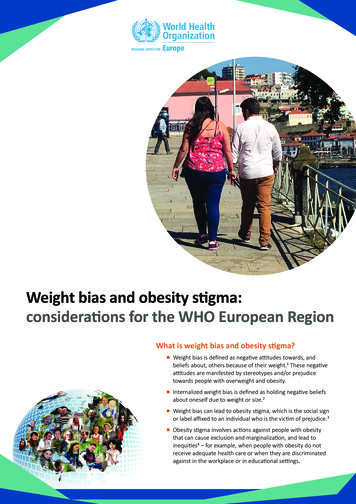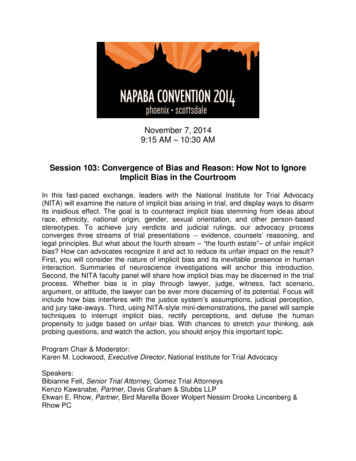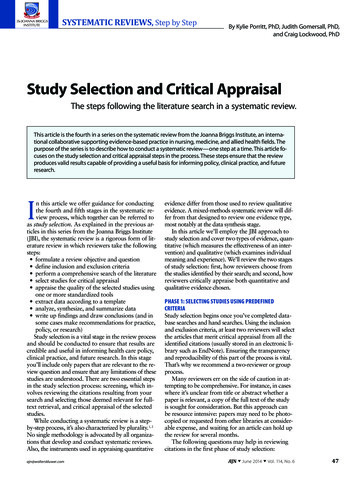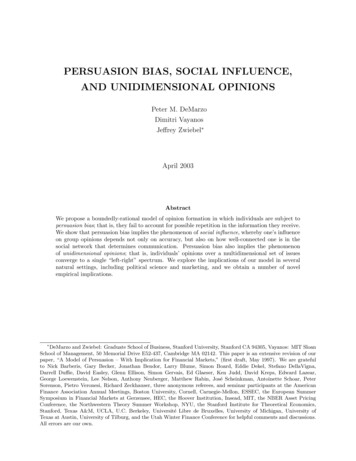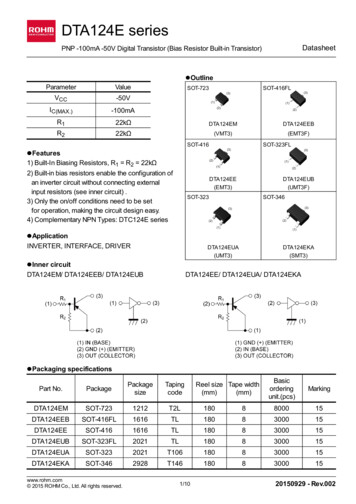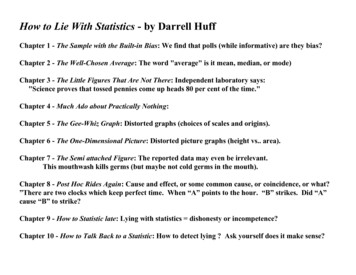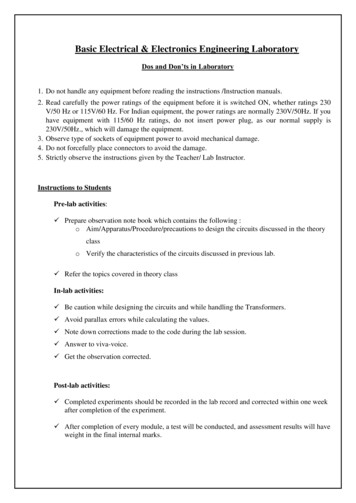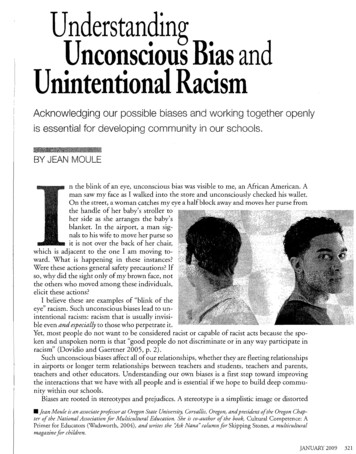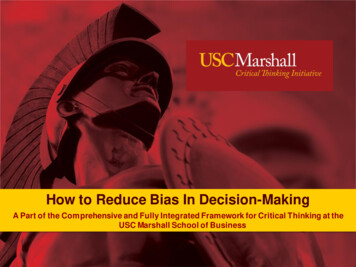
Transcription
How to Reduce Bias In Decision-MakingA Part of the Comprehensive and Fully Integrated Framework for Critical Thinking at theUSC Marshall School of Business
USC Marshall Critical Thinking Initiative The USC Marshall Critical Thinking Initiative is an on-going school wideeffort to enhance our students’ critical thinking skills in order to make themmore successful problem solvers. Its key components include The 5 Step USC-CT Problem Solving Process which is designed to help studentstackle ambiguous, ill-defined challenges. The START Concept Analysis which is designed to teach fundamentalconcepts/formulas that are utilized within the USC-CT Process. Learning Modules which are designed to enhance specific skills such as how toreduce biases, how to enhance creativity, and how to evaluate claims & evidence. This lesson focuses on Reducing Biases in Decision Making.22
Reducing Biases(Note: This document corresponds to the related video which provides a briefintroduction to the subject. More in-depth coverage will occur insupplemental readings and classroom exercises.)33
Reducing Biases Objective: This module is designed to help students reduce and even eliminateon-going biases that hamper successful decision-making. Approach: The approach surveys an array of biases to help students recognizethem, while outlining various techniques to help students reduce and hopefullyeven eliminate them.Hindsight BiasOverconfidenceAnchoring BiasSelective PerceptionConfirmation BiasFraming BiasAvailability BiasSunk Costs & ConstraintsSelf-Serving Bias44
Session Goals Recognize cognitive biases that influence yourthinking and decision making Learn how to overcome these biases in order tomake better decisions or complete strongeranalysis Understand why it matters55
Decision Making What do we mean by decision making?– When problems or issues arise, we need to make adecision about what to do– We engage in a decision making process to come tothe action we want to take– During the process, we often use “rules of thumb” orheuristics or shortcuts– We make better decisions using critical thinking66
Cognitive Biases What is a bias?– We tend to believe or seek out information topreserve our opinions or beliefs– This can cause a gap in how we reason andhow we should reason– This causes us to make bad decisions77
Decision Making BiasesOverconfidenceHindsightImmediate GratificationAnchoring EffectSelf-servingSunk CostsDecision-MakingErrors and BiasesResourceConstraintsSelective ility88
Overconfidence Bias When we are given factual questions and askedto judge the probability that our answers arecorrect, we tend to be far too optimistic.99
Criminal or Movie Star?1010
Anchoring Bias Fixate on initial information and fail to adjust forsubsequent information. This also happens when we are blinded by firstimpressions or influenced by first impressions,ideas, prices, or estimates relative to inforeceived later.1111
1212
Selective Perception See things from our own personal perspective Organize and interpret events/information basedon this perception Influences what we pay attention to and theproblems we identify, and the alternatives wedevelop or consider. CONFIRMATION BIAS is a specific case1313
Confirmation Bias1414
Framing Tendency to be influenced by the way a problemis formulated even though it should not affect thesolution.1515
Availability Bias Rely upon knowledge that is readily availablerather than examine other alternatives orprocedures. The most recent and memorable information isgiven preference.1616
Sunk Costs & Constraints Tendency to “honor” already spent resourcesthat are not affected by present or futuredecisions. Economists would label this behavior "irrational”– it is inefficient because it misallocatesresources by depending on information that isirrelevant to the decision being made. Throwing good money after bad.1717
Self Serving Bias Take personal credit for success while blamingoutside sources for our failures. Selecting information or making decisions thatfurther our own self-interests instead of theorganization or team.1818
Working in Groups Conformity & Group Think Group Shift Escalation of Commitment Use a clear decision making process likeUSC-CT to reduce these errors.1919
20
2008 Financial Meltdown Selective Perception & Anchoring – Merrill Lynch– Housing boom, Lehman Bros. mortgage-based product success Overconfidence Bias – Many players– Boom will continue, Banks happy, Homeowners happy Confirmation Bias – Financial Analysts & Traders– Focused on the good news and upside, ignored bad news Availability Bias & Self-Serving Bias Groupthink – Merrill Lynch– No one spoke up, Dissenters were silenced2121
Reducing Biases Use a PROCESS Start with a clean slate Challenge the status quo Seek multiple perspectives Search for more information & data Play Devil’s Advocate Reflect on your own views & values2222
Working the USC-CT ModelUSCCTUncover the variouspotential problems,challenges &opportunities vis-à-visorganizational goals.Select the mostcritical problem(s),challenge(s) and/oropportunity(ies).Prioritize.Create amultitude ofpotentialsolutions.Choose thesolution(s) thathas the potentialto be the mosteffective.Translate yoursolution(s) intoan effectiveimplementationplan.With each step, check and challenge your thinking.What biases might be getting in the way?Am I limiting the possibilities?2323
Kahneman’s 3 Key Questions Is there any reason to suspect the people making therecommendation of biases based on self-interest, overconfidence,or attachment to past experiences? Realistically speaking, it isalmost impossible for people to not have these three influence theirdecisions.Have the people making the recommendation fallen in love with it?Again, this is almost an inevitability because, in most cases,people wouldn't make the recommendation unless they loved it.Was there groupthink or were there dissenting opinions within thedecision-making team? This question can be mitigated before thedecision-making process begins by collecting a team of people whowill proactively offer opposing viewpoints and challenge theconventional wisdom of the group.2424
Most Importantly BE AWARE!Keep in mind that you can’t escape these biasesbut if you are aware of them and challenge them,you will be become a stronger critical thinker andbetter decision maker overall!2525
USC Marshall Critical Thinking InitiativeRecap2626
USC Marshall Critical Thinking Initiative The USC Marshall Critical Thinking Initiative is an on-going school wideeffort to enhance our students’ critical thinking skills in order to make themmore successful problem solvers. Its key components include The 5 Step USC-CT Problem Solving Process which is designed to help studentstackle ambiguous, ill-defined challenges. The START Concept Analysis which is designed to teach fundamentalconcepts/formulas that are utilized within the USC-CT Process. Learning Modules which are designed to enhance specific skills such as how toreduce biases, how to enhance creativity, and how to evaluate claims & evidence.Check them all out!2727
The USC Marshall Critical Thinking Initiative is an on-going school wide effort to enhance our students’ critical thinking skills in order to make them more successful problem solvers. Its key components include The 5 Step USC-CT Problem Solving Process which is designed t
